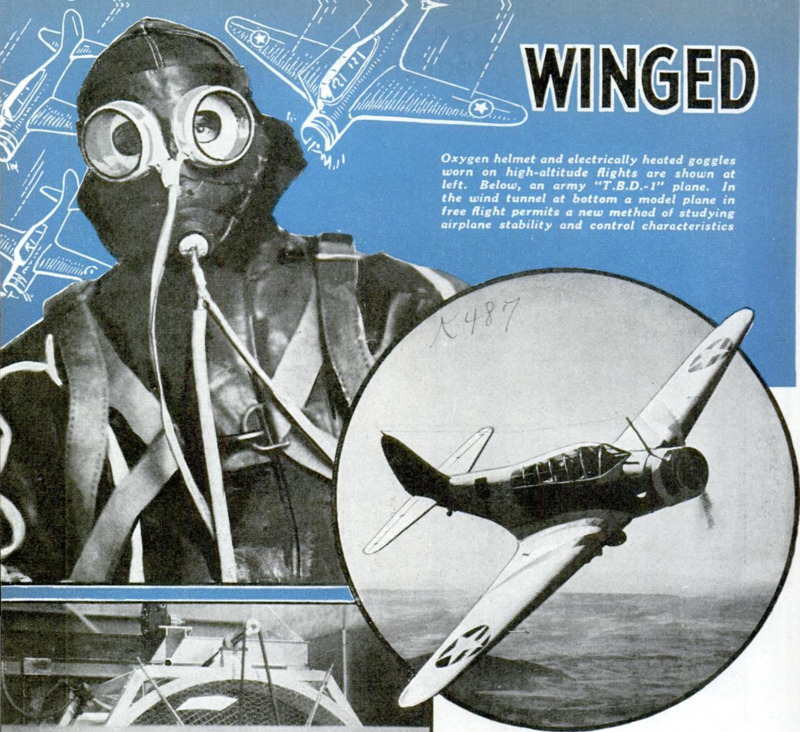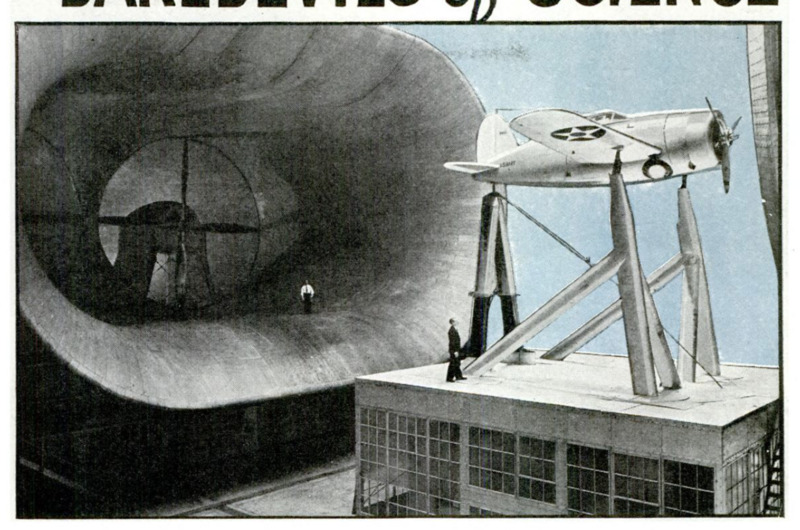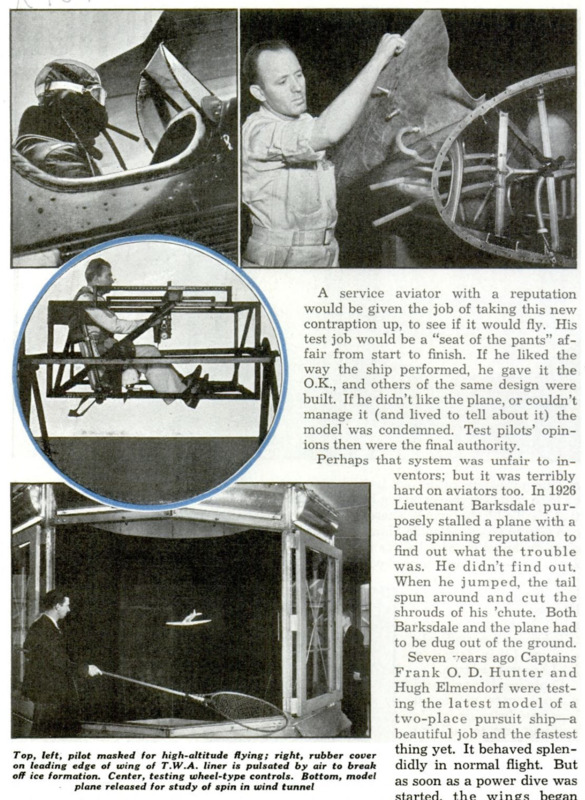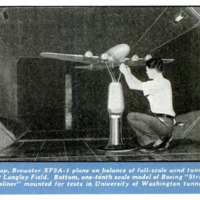YOU'D think that skis would be fairly simple to a crack pilot of the Army Air Corps, when any coed can master them in a short time. Yet to say that Captain Frank G. Irvin was having difficulties would be a rank understatement. The skis were on a new Boeing pursuit plane, being tried out for winter landings at Wright Field. In a routine test, Irvin was diving at 350 miles an hour when the front end of one ski came loose; and the wide surface, dangling broadside against the air stream, made the plane unmanageable. It required all of Irvin's strength to hold the stick back while the ship continued its dive. To pull out was impossible. With the ground approaching at six miles a minute, an immediate jump was imperative, yet Irvin doubted if he could survive exposing his head to that terrific blast of wind. There was only one way to go out - double himself into as close an imitation of a ball as is possible for a six-foot man in a cramped cockpit. He got one leg under him. To get the other up he had to release the stick. Immediately the tail snapped forward, cat- apulting Irvin out in a heels-over-head spin. Centrifugal force and air pressure prevented him from bringing up his outflung arm to pull the rip-cord. The earth whirled about, sometimes seemingly above, sometimes below; yet always nearer. Irvin finally worked his left hand up from the elbow, close to his body, for a backhand pull. Half an hour later he was putting a duplicate of the wrecked plane into another dive. And all for science. When the army bought its first airplane, the Wright Brothers were their own test pilots, proving by repeated flights that the kite-like affair could meet army specifica tions. Then the World War came along; and everybody had ideas. A designer, working by rule of thumb and with no preliminary research, would incorporate his brain-child into a finished plane, which he would offer to the army or navy. A service aviator with a reputation would be given the job of taking this new contraption up, to see if it would fly. His test job would be a “seat of the pants” af- fair from start to finish. If he liked the way the ship performed, he gave it the OK, and others of the same design were built. If he didn’t like the plane, or couldn’t manage it (and lived to tell about it) the model was condemned. Test pilots’ opinions then were the final authority. Perhaps that system was unfair to inventors; but it was terribly hard on aviators too. In 1926 Lieutenant Barksdale purposely stalled a plane with a bad spinning reputation to find out what the trouble was. He didn't find out. When he jumped, the tail spun around and cut the shrouds of his 'chute. Both Barksdale and the plane had to be dug out of the ground. Seven years ago Captains Frank O. D. Hunter and Hugh Elmendorf were testing the latest model of a two-place pursuit ship - a beautiful job and the fastest thing yet. It behaved splendidly in normal flight. But as soon as a power dive was started, the wings began turning in a spin irom which the pilot could not recover. Hunter succeeded in getting clear at only 150 feet - and lived, though terribly battered; Elmendorf spun into the ground with the ship. Lieutenant Woodring, one of the army’s outstanding pilots - a racer and stunter de luxe - took another one of these ships up to find out just what the trouble was. A giant for strength, he succeeded in pulling out of the same tight power spin, only to have the plane go to pieces around him, scattering parts over a square mile of countryside. Woodring had no chance to use his parachute. That was the end of that. The army-wasthrough with sacrificing its best pilots to find out if inventors and engineers were right. Today organized research takes the place of “the seat of the pants.” Every plane now built for the army or navy is put through severe tests at the Langley Field laboratories of the National Advisory Comutittee for Aeronailtics before being taken into the air. Scale models are built first, fested in the variable-density wind tunnel under conditions that simulate the actual air pressures met in flight. The free-flight wind tunnel permits the models to be tested for stability and control. The spinning characteristics of these models are then tested in the free-spinning tunnel, dangerous faults eliminated, before a full-sized plane is ever built. Then the manufacturer is required to demonstrate, with his own pilot, that the plane can be flown with safety. An army pilot, from the materiel section at Wright Field, flies alongside the ship being demonstrated, while a civilian aviator puts it through stalls, dives, and other maneuvers. If the plane gets by this demonstration, it is taken over by the Materiel Section and subjected to a scientific analysis. First the air-speed meter must be calbrated. A short distance from Wright Field a two-mile speed course is laid out on level ground, a highway at one end, a steep hill a short distance from the other. The pilot must come in at top speed,without a preliminary dive, level off five or ten feet from the ground, time the two-mile run with a stop-watch as he passes the pylons at each end. Then he pulls up, notes the readings of the meter and watch, comes in again at the same indicated speed from the other direction, so he will have a course both with and against the wind. Next time he must repeat this exactly ten miles an hour slower, and so on until the stalling speed is reached. Flying so close to the ground is always dangerous, especially with planes hitting 400 miles an hour, stalling at close to a hundred. It is doubly dangerous when the pilot must keep his plane absolutely level, keep the air-speed indicator at a constant reading, and work a stop-watch on the split second. “Flying the sawtooth,” so called because the barograph record resembles the business edge of a saw, is used to determine at what attitude the plane will climb fastest, at different heights. The pilot will climb from 1,000 to 2,000 feet at, say 380 miles an hour. Then, back to 1,000 feet, and with the same throttle setting he will pull the stick back until the air-speed meter reads 360 miles per hour, and so on. A plane, you will understand, does not necessarily climb fastest (vertically) while the air-speed meter shows the highest reading. Neither does the rate of climb remain the same, for the same angle of incidence, at all altitudes. And since climbing ability is so important to a fighting ship, the maximum performance at all altitudes must be determined. This sawtooth gets to be ticklish business as the plane nears its ceiling. Lieutenant Julian Hadden dropped his pencil while flying at 34,000 feet. To reach it he had to remove the oxygen breather from his mouth. Before he could get his hand on the pencil he passed out. He came to at 9,000 feet to find his plane in a power dive, and on fire. After pulling out and battling the flames until severely burned, he had to jump at 3,000 feet. There are dozens of other tests these pilots must make. All of them are routine, most of them are dangerous.Yet these pilots are not chosen for their devil-may-care attitude. Quite the contrary, they are the pick of the Air Corps brains, selected for their engineering background, and willingness to follow instructions to the letter though it might mean endangering their lives. Added to these qualities of steadiness must be extraordinary flying skill, and the faculty of thinking clearly in emergencies. These are the daredevils of science.








